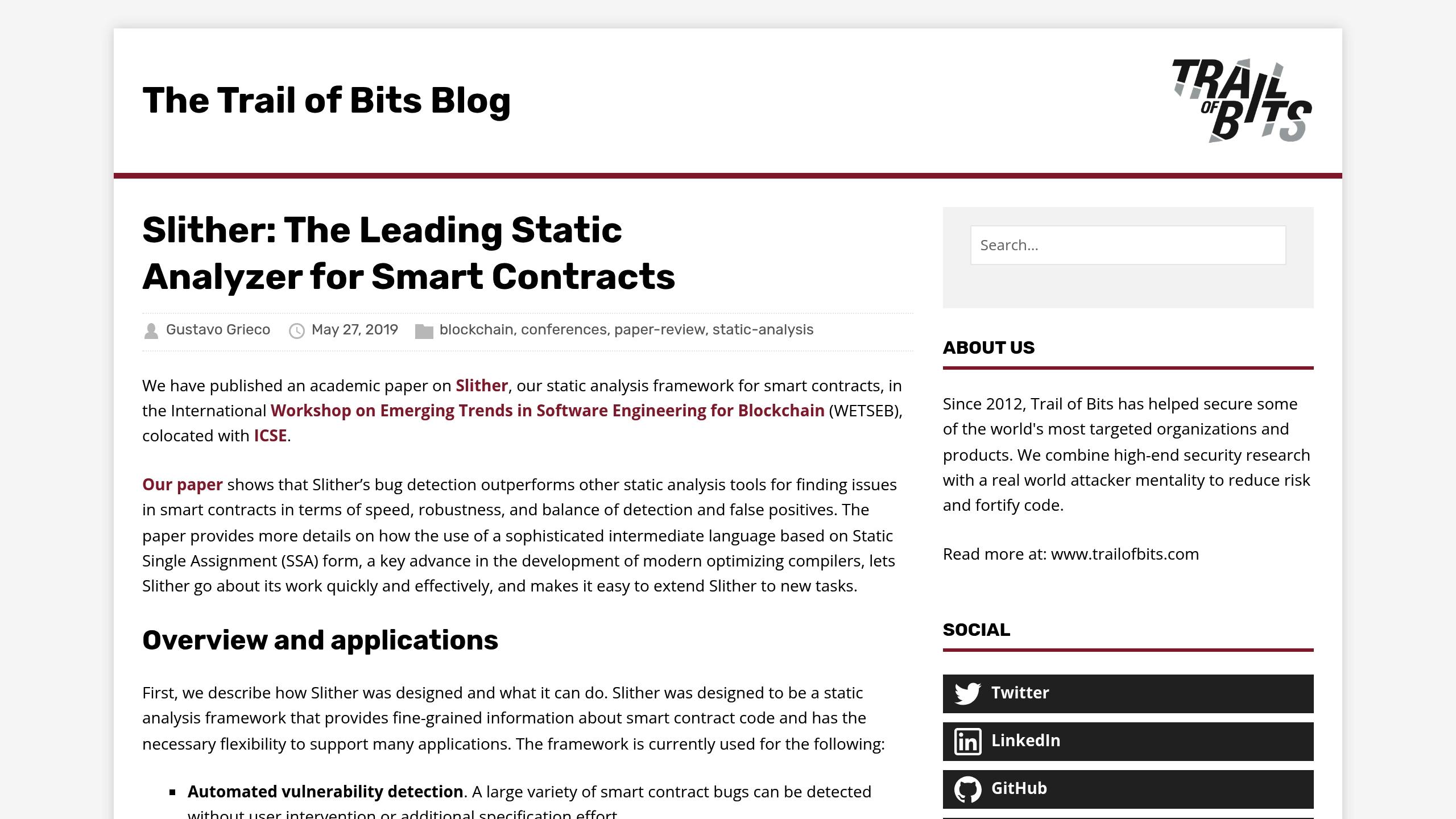Smart contract scanners are essential for blockchain security. They detect vulnerabilities and malicious behavior in smart contracts using static analysis, dynamic testing, and AI. Here’s why they’re important:
- Massive losses: Over $49 billion lost in crypto, with half tied to smart contract flaws.
- Examples of hacks: The DAO hack ($60M in 2016) and Poly Network breach ($600M in 2021) highlight the risks.
- Key benefits: Scanners help developers fix bugs and protect users by flagging scams early.
How They Work:
- Static Analysis: Examines code structure for issues like logic errors and variable misuse.
- Dynamic Testing: Simulates attacks to uncover hidden vulnerabilities.
- AI Detection: Flags patterns in malicious contracts, like hidden transfer taxes.
Why Use Them:
- For Developers: Continuous security monitoring and integration into workflows.
- For Users: Tools like Token Sniffer track millions of tokens and spot scams.
Key Features to Look For:
- Multi-chain support, AI-powered analysis, automated monitoring, and detailed reports.
Bottom line: Scanners like SolidityScan and SmartAuditor.AI are critical for preventing financial losses and securing blockchain ecosystems.
Using Slither to Scan Smart Contracts for Vulnerabilities

How Contract Scanners Work
Smart contract scanners use a mix of techniques to find vulnerabilities and detect malicious code.
Code Review Methods
Static analysis inspects code without running it, helping to identify potential threats. Tools like Slither analyze code structure, syntax, and logic while keeping track of data flows and variables .
| Analysis Component | Focus Area |
|---|---|
| Syntax Analysis | Issues in code structure and formatting |
| Logic Review | Problems in control flow or logic |
| Pattern Matching | Recognized vulnerability patterns |
| Value Tracking | Manipulation of variables and fund flow |
Testing and Simulation
Tools like MythX use symbolic analysis and input fuzzing to uncover bugs that static analysis might miss . For example, ContractFuzzer has proven its value by exposing major vulnerabilities in the DAO contract and Parity wallet implementations .
Machine Learning Detection
Machine learning is a newer method in contract scanning. It identifies risk patterns across contracts. De.Fi Shield uses this approach during pre-launch phases to flag suspicious tokens and prevent scams like honeypots .
Similarly, Quick Intel uses machine learning to alert users about contracts with hidden transfer taxes, particularly on the Binance Smart Chain . These advanced methods help pinpoint malicious contracts, which we’ll explore further in the next section.
sbb-itb-dd9e24a
Detecting Malicious Contracts
Smart contract scanners play a critical role in identifying and stopping blockchain attacks. Their impact is clear when examining major hacks and their ability to prevent scams.
Major Security Incidents
The Genesis Alpha DAO hack in February 2019 highlights the importance of smart contract scanning. In this case, an attacker exploited repeated function calls, leading to losses of around $15,000. To address such vulnerabilities, ChainSecurity upgraded their Securify scanner to detect similar attack patterns .
| Vulnerability Type | Scanner Detection Method | Prevention Mechanism |
|---|---|---|
| Repeated Calls | Tracks function arguments | Identifies repeated calls with varying outcomes |
| Untrusted Contracts | Checks address manipulation | Verifies contract reliability |
| Static Call Issues | Analyzes CALL/STATICCALL | Monitors instruction sequences |
These incidents expose past weaknesses while showing how scanners can proactively address potential threats.
Prevented Scams
Smart contract scanners don’t just react to attacks – they actively stop scams before they cause harm. For instance, SmartAuditor.AI has analyzed nearly one million lines of code across nine blockchains, demonstrating their effectiveness .
One example involves a front-runner scam targeting Ethereum users. The malicious contract included a StartNative function that seemed harmless but secretly redirected user funds to the scammer’s wallet . Scanners caught this by:
- Analyzing hidden logic in the startArbitrageNative function
- Flagging unusual fund flows
- Detecting concealed wallet addresses
"SmartAuditor.AI mission is to help users identify and address vulnerabilities in smart contracts and make a more secure Web3 ecosystem." – SmartAuditor.AI
Scanners are also excelling at identifying NFT-related scams. For example, they flagged suspicious calls like SafeTransferFrom during minting operations, which was the method used in the Momoco NFT project scam .
These tools detect various warning signs, including:
- Access control flaws
- Re-entrancy vulnerabilities
- Unchecked external calls
- Hardcoded suspicious addresses
- Misuse of
tx.origin - Manipulation of storage variables
Their ability to spot these issues is making blockchain networks safer for users.
Selecting and Using Contract Scanners
Key Scanner Requirements
When picking a smart contract scanner, developers and traders should look for tools with strong security features. For example, SolidityScan offers over 494 vulnerability detectors , showcasing the kind of thorough capabilities modern tools should have.
Here are some key features to consider when evaluating a smart contract scanner:
| Feature | Purpose | Benefit |
|---|---|---|
| Multi-chain Support | Analyze contracts across networks | Works with Ethereum, Polygon, Avalanche, Binance |
| AI-powered Analysis | Advanced vulnerability detection | Identifies threats in real time |
| Integration Options | Connect with development tools | Compatible with GitHub and Slack |
| Report Generation | Documentation and sharing | Exports reports as PDFs with verification options |
| Automated Monitoring | Continuous security checks | Monitors code security over time |
Once you’ve identified a scanner with these features, it’s time to put it to work.
Scanner Usage Guide
After selecting the right scanner, follow these steps to ensure your smart contract’s security is thoroughly monitored:
- Upload Your Code: Start by uploading your contract code or linking your repository for automated scanning.
- Review Scanner Reports: Focus on key insights provided by the tool, such as:
- Severity levels of vulnerabilities
- Possible attack vectors
- Suggestions for code optimization
- Recommendations for improving security
- Prioritize Fixes: Address vulnerabilities based on their risk level. AI-driven insights can help you make informed decisions about which issues to tackle first.
By following these steps, you’ll create a solid foundation for ongoing security. But don’t stop there – layering additional safeguards is essential.
Complete Security Setup
Achieving full security requires combining automated scanning with other protective measures. For instance, SmartAuditor.AI analyzed 975,854 lines of code across 9 blockchains , highlighting the scale of protection necessary.
Here’s how to build a well-rounded security system:
| Security Layer | Implementation | Verification |
|---|---|---|
| Automated Scanning | Daily code checks | Receive real-time alerts |
| Manual Audits | Professional security reviews | Obtain detailed reports |
| Continuous Monitoring | Track changes in code | Get update notifications |
| Team Collaboration | Share findings across teams | Coordinate fixes effectively |
Experts in the field emphasize the importance of this approach:
"A perfect tool for startup projects in Web 3.0! Personally used this as a reference tool while morphing contracts and governance protocols to have a second set of eyes in real-time. Nothing beats actual audits, but the access and ease of use of Solidity Scan make it a no-brainer!"
– Jon Greenwood, Integrations, GovernorDAO
To maximize protection, combine your scanner with other security tools for continuous monitoring and improvement.
Conclusion
Key Takeaways
Smart contract scanners play a vital role in identifying vulnerabilities and malicious code. By using advanced techniques like symbolic execution, these tools can pinpoint exploitable weaknesses that might lead to financial losses .
The effectiveness of modern scanning tools is evident. For example, CredShields has protected over $1 billion in contracts and discovered more than 1,000 vulnerabilities across 300,000 lines of code . This highlights their importance in strengthening blockchain security.
Here’s how these tools contribute to better security in blockchain networks:
| Detection Method | Security Impact | Examples |
|---|---|---|
| Symbolic Execution | Identifies bugs | Prevents fund theft |
| AI-powered Analysis | Improves code quality | Boosts efficiency |
| Real-time Monitoring | Offers continuous defense | Threat alerts |
Security Best Practices
To address evolving threats, it’s essential to pair these tools with robust security practices. In September 2024 alone, DeFi platforms reported losses of $114 million due to hacks, with $45 million (40%) stemming from smart contract exploits .
A strong security approach involves not just scanning but also layering additional safeguards. Experts stress the importance of integrating scanning tools into a broader security strategy for both investors and audit teams .
Consider these strategies to enhance protection:
| Security Layer | Implementation | Risk Reduction |
|---|---|---|
| Development Practices | Apply CEI and Emergency Stop | Minimizes vulnerabilities |
| Testing Protocols | Deploy on testnets first | Catches issues early |
| External Validation | Use audits and bounty programs | Strengthens defenses |
| Continuous Monitoring | Schedule regular scans | Ensures ongoing safety |
"Security is not a binary property. It’s a spectrum"
This insight from Vitalik Buterin emphasizes that smart contract scanners should be part of a larger security framework, not standalone solutions.
Defx, a decentralized exchange, demonstrates this approach by embedding scanning protocols to protect its trading platform and users effectively.
